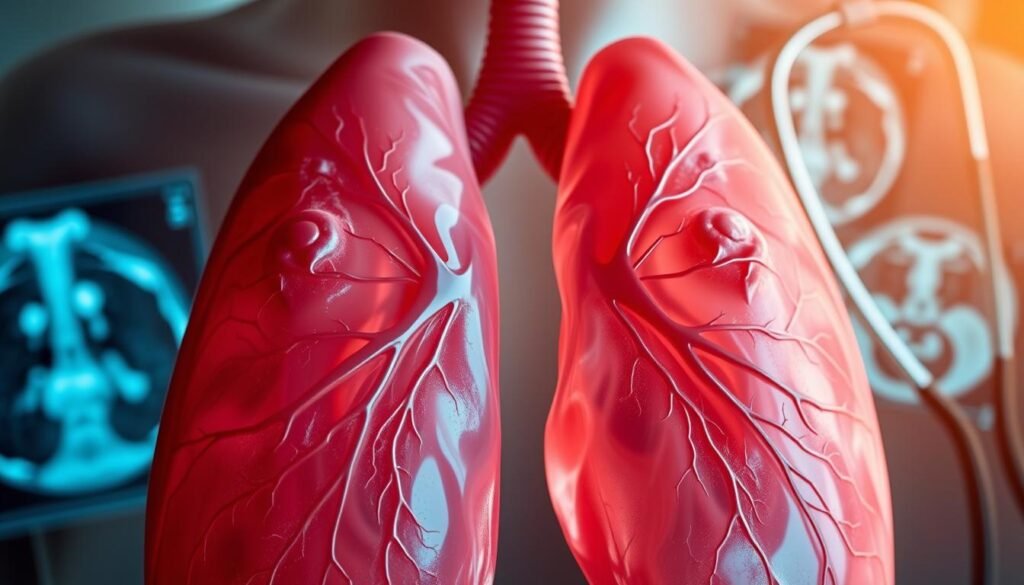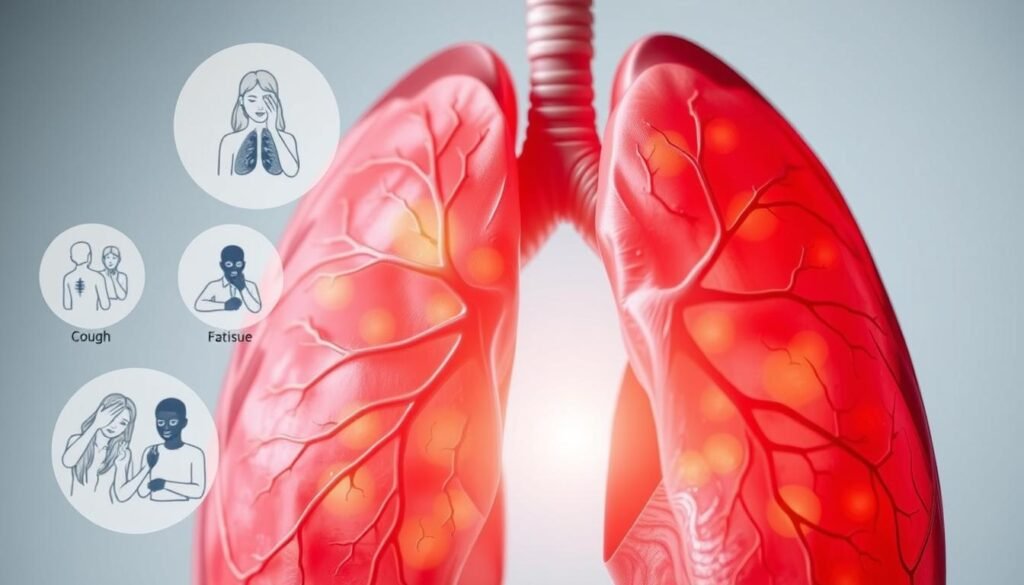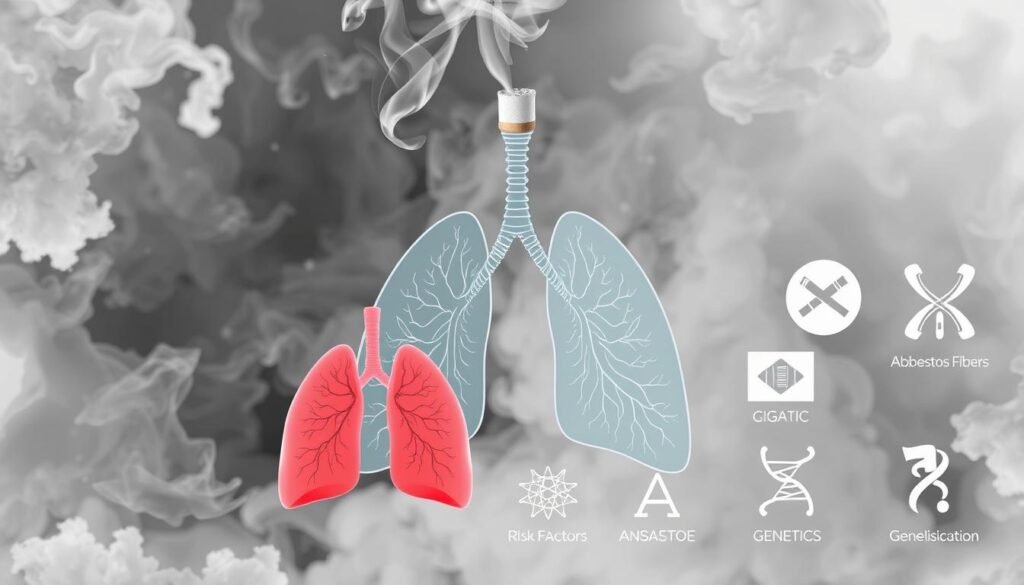Did you know that 80% of people with finger clubbing are likely facing lung cancer? Finger clubbing makes fingertips look thicker than normal. This fact highlights the need to know lung cancer’s early signs. These signs can be subtle but are critical for finding effective treatment early.
Many don’t realize symptoms like a continuous cough or chest pain could indicate lung cancer. Recognizing these signs early is crucial not just for diagnosing lung cancer, but for taking steps to improve health and wellbeing.
Key Takeaways
- The early signs of lung cancer can include persistent coughing and chest pain.
- Awareness of symptoms is key to early diagnosis and treatment effectiveness.
- Finger clubbing is a significant indicator, with 80% associated with lung cancer cases.
- Not all lung cancers show symptoms until they’re advanced, making early detection challenging.
- Prompt medical consultation is crucial if any lung cancer symptoms arise.
Understanding Lung Cancer
Lung cancer is the top cause of cancer deaths worldwide. It happens when lung cells grow out of control. There are two main kinds of lung cancer: non-small cell and small cell. About 85% of cases are non-small cell lung cancer. It grows slower than the other kind. Small cell lung cancer is faster and often linked to heavy smoking.
Knowing the types of lung cancer helps catch it early. Smoking is the biggest cause. The more you smoke, the higher your risk. Being around smoke from others also raises your risk. Things like radiation, radon, and being near harmful substances can increase the risk too.
This illness can cause problems like breathlessness and pain. It can also spread inside the body. Symptoms include coughing, losing weight, and feeling tired. For more on symptoms, check out this website. Recognizing these signs early is key to starting treatment quickly.
New treatments are helping fight lung cancer better. Options like chemo, radiation, and targeted treatments make a big difference. Catching the disease early is crucial. It leads to more effective treatment, higher survival rates, and better life quality for patients.
Common Lung Cancer Symptoms
It’s very important to know the common signs of lung cancer early on. Paying close attention to changes in how you breathe is key. Symptoms may point to big health issues.
Persistent Cough
If you have a cough that won’t go away for over eight weeks, it might be lung cancer. This cough gets worse with time and can interrupt your day. Watching for new symptoms that appear is crucial.
Coughing Up Blood
Finding blood when you cough, even a little, is a serious warning sign. It could mean lung cancer or other big health problems. If you see this, seeing a doctor right away is vital.
Chest Pain
Chest pain can mean lung cancer, especially if it gets sharper when you breathe or cough. This pain varies; it can be sharp or dull. It may be due to cancer touching areas near it. If you feel this pain, getting help from a doctor quickly is important.
The Importance of Early Diagnosis
Lung cancer is the second most common cancer in the United States. It’s also the top cause of cancer-related deaths. Making an early diagnosis of lung cancer is crucial.
Spotting lung cancer symptoms early can lead to quick action. This greatly improves chances of successful treatment.
It’s vital to understand how finding lung cancer early affects survival. Early signs like a constant cough or losing weight without trying are often missed. Raising awareness about these signs can push people to get help sooner. Studies show early detection greatly boosts survival rates, showing we need more education on the signs of lung cancer.
The American Cancer Society suggests yearly scans for those 50 to 80 who smoked a lot. These scans can catch lung cancer early, saving lives. It’s important to have these scans at places that know how to find lung cancer.

However, only 21% of lung cancers are found when they’re still just in one spot. We need more talks on the value of early checks and acting fast between doctors and patients. Starting these chats could save lives. For those at risk, early action could mean better treatment and outcomes.
For more info on early lung cancer signs, visit this resource. Knowing these signs is key in fighting lung cancer effectively early on.
How Do I Know If I Have Lung Cancer
Lung cancer is the second most common cancer in the United States. Many people ask themselves, how do I know if I have lung cancer? Finding it early is hard because there are usually no signs at first. This often means it’s not found until it’s very advanced. If you’ve had a cough for more than eight weeks, it might be a sign of lung cancer.
If you keep getting sick with things like bronchitis or pneumonia, it could be a clue. Coughing up even a little bit of blood is another warning sign. Feeling out of breath can happen when tumors block your airways. A hoarse voice may also be a sign if a tumor affects your vocal cords.

People with lung cancer might feel chest pain. It feels like tightness or pressure because of the nerves affected. People who smoked a lot in the past, especially if they quit in the last 15 years, should pay attention. This includes those between 55 to 80 years old. Getting checked regularly can help find it early, which is crucial.
Tests are key to confirming if someone has lung cancer. If a screening looks odd, doctors will do more tests like scans and biopsies. Sadly, many people don’t know they have lung cancer until it’s very advanced. This shows how important it is to know the symptoms such as ongoing cough, chest pain, and trouble breathing.
| Symptom | Description | Potential Indicators |
|---|---|---|
| Persistent Cough | Cough lasting eight weeks or more | Lung cancer or other lung conditions |
| Coughing Up Blood | Presence of blood in sputum | Possible lung cancer symptom |
| Shortness of Breath | Difficulties in breathing, wheezing | May indicate lung cancer blockage |
| Chest Pain | Tightness in the chest, pain | May indicate tumor presence |
| Frequent Respiratory Infections | Recurring bronchitis or pneumonia | May relate to blocked airways |
Knowing what to look out for can help catch lung cancer early. If you notice these signs, see a doctor right away. They can make sure you get the right tests and treatments quickly.
Risk Factors Associated with Lung Cancer
It’s vital to know what increases the risk of lung cancer. There are two main types of risk factors: behavioral and environmental. Knowing these can help people protect their health.
Smoking and Tobacco Use
Smoking is the biggest risk for lung cancer, causing about 90% of cases. One-third of all cancer cases are due to tobacco. Many smokers want to quit, and more than half try each year. But only 7% succeed.
There are ways to help quit smoking, like prescription drugs Varenicline and Bupropion. Nicotine replacements also help if used right. Plus, counseling can offer support and advice. Sadly, only a few people get the help they need to stop smoking.
Environmental Exposures
Being around certain environmental dangers can increase lung cancer risk. For example, asbestos exposure is linked to most mesothelioma cases. Radon gas can also cause lung cancer deaths among non-smokers. Pollution, secondhand smoke, and metals like arsenic add to this risk. Genetics can make some people more likely to get lung cancer too.
To learn more about these risk factors, explore this detailed overview.

| Risk Factor | Contribution to Lung Cancer |
|---|---|
| Smoking and Tobacco Use | Responsible for approximately 90% of lung cancer cases |
| Asbestos Exposure | Linked to 70%-80% of mesothelioma cases |
| Radon Exposure | Accounts for about 30% of lung cancer deaths in non-smokers |
| Air Pollution | Increases overall cancer risk |
| Family History | Twice the likelihood of developing lung cancer |
Causes of Lung Cancer
It’s vital to know why lung cancer happens to prevent it and catch it early. The main reason is smoking, which causes about 90% of lung cancer. This includes smoking cigarettes and pipes, both of which raise the risk greatly.
Radon exposure is another big cause of lung cancer, especially in the United States. Around 1 in 15 homes has high levels of this gas. Even if you don’t smoke, radon can still cause cancer changes in your lungs. Testing your home for radon can help you know your risk.
There are also other lung cancer triggers to look out for. Being around harmful chemicals like asbestos, arsenic, cadmium, and certain oils can increase your cancer risk. Working in specific jobs with these materials can be risky. Smoking makes these risks even worse.
Having a family history of lung cancer can also make you more likely to get it. Genetic traits may affect how your lungs react to toxins and carcinogens.
Think about where you live as well. Places with a lot of air pollution pose a higher lung cancer risk. Being around secondhand smoke is also dangerous, even if you don’t smoke yourself.
While smoking and pollution are big risks, don’t forget other factors like past lung diseases and jobs with exposure to harmful substances. To learn more about lung cancer risks and how to prevent them, check out this resource.
Lung Cancer Stages
It’s very important to know the different stages of lung cancer. They go from stage 0 to stage IV, showing how severe the disease is. Knowing the exact stage is key for choosing the right treatment.
Understanding Stage 0 to Stage IV
Lung cancer stages tell us about the tumor’s size, where it is, and if it has spread. There are main stages you should know:
| Stage | Description | Characteristics |
|---|---|---|
| Stage 0 | Carcinoma in situ | Non-invasive tumor within the top lining of the lung or bronchus. |
| Stage I | Localized lung cancer | Tumor size defines sub-stages (1A, 1B) with no spread to lymph nodes. |
| Stage II | Advanced local disease | Involvement of regional lymph nodes; further divided into IIA and IIB. |
| Stage III | Locally advanced | Further spread into lymph nodes; categorized as IIIA, IIIB, or IIIC. |
| Stage IV | Metastatic disease | Cancer spread to other body parts, like the brain or liver. |
Stage IV lung cancer shows the disease has spread far. This stage is a key moment for making treatment choices. Each stage is critical for the patient’s outlook and choosing treatments. Knowing about these stages helps people with lung cancer make informed health decisions.
Lung Cancer Screening Tests
Screening tests are key for early detection of lung cancer, especially for high-risk people. The US Preventive Services Task Force suggests yearly screenings. They recommend low-dose computed tomography (LDCT) for those 50 to 80 years old with a 20 pack-year smoking history. This is crucial for current or recent smokers due to their increased lung cancer risk.
However, lung cancer tests can have downsides. False positives may lead to unneeded procedures. Also, there’s a concern about radiation exposure. Screening should stop at 81, if you’ve been smoke-free for 15 years, or if you’re not fit for surgery.
Most insurance plans, including Medicare, typically cover these screenings. Yet, additional follow-up procedures might cost extra. These screenings often come with advice on quitting smoking. This provides crucial help in lowering lung cancer risk and boosting overall health.